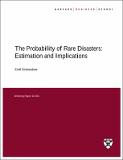| dc.contributor.author | Siriwardane, Emil Nuwan | |
| dc.date.accessioned | 2015-11-10T14:16:19Z | |
| dc.date.issued | 2015-11-10 | |
| dc.identifier.citation | Siriwardane, Emil. "The Probability of Rare Disasters: Estimation and Implications." Harvard Business School Working Paper, No. 16-061, November 2015. | en_US |
| dc.identifier.uri | http://nrs.harvard.edu/urn-3:HUL.InstRepos:23519626 | |
| dc.description.abstract | I analyze a rare disasters economy that yields a measure of the risk neutral probability of a macroeconomic disaster, p*t . A large panel of options data provides strong evidence that p*t is the single factor driving option-implied jump risk measures in the cross section of firms. This is a core assumption of the rare disasters paradigm. A number of empirical patterns further support the interpretation of p*t as the risk-neutral likelihood of a disaster. First, standard forecasting regressions reveal that increases in p*t lead to economic downturns. Second, disaster risk is priced in the cross section of U.S. equity returns. A zero-cost equity portfolio with exposure to disasters earns risk-adjusted returns of 7.6% per year. Finally, a calibrated version of the model reasonably matches the: (i) sensitivity of the aggregate stock market to changes in the likelihood of a disaster and (ii) loss rates of disaster risky stocks during the 2008 financial crisis. | en_US |
| dc.language.iso | en_US | en_US |
| dash.license | OAP | |
| dc.title | The Probability of Rare Disasters: Estimation and Implications | en_US |
| dc.type | Research Paper or Report | en_US |
| dc.description.version | Author's Original | en_US |
| dc.relation.journal | Harvard Business School working paper series # 16-061 | en_US |
| dash.depositing.author | Siriwardane, Emil Nuwan | |
| dc.date.available | 2015-11-10T14:16:19Z | |
| dash.contributor.affiliated | Siriwardane, Emil | |


